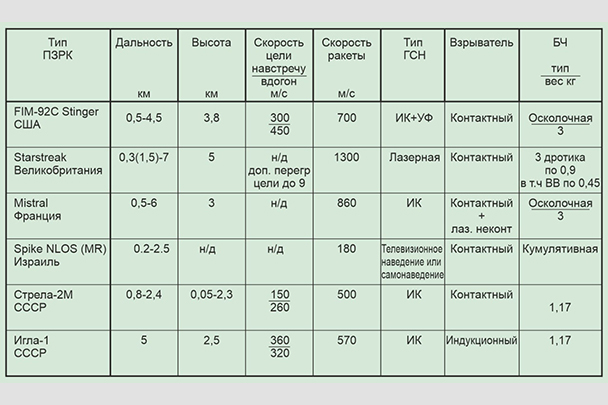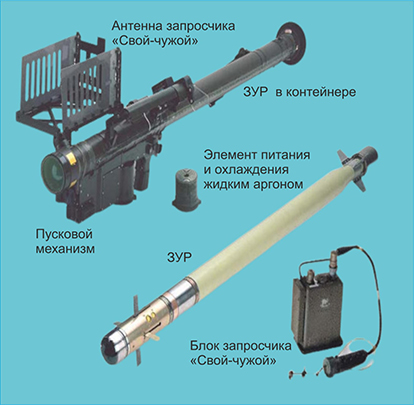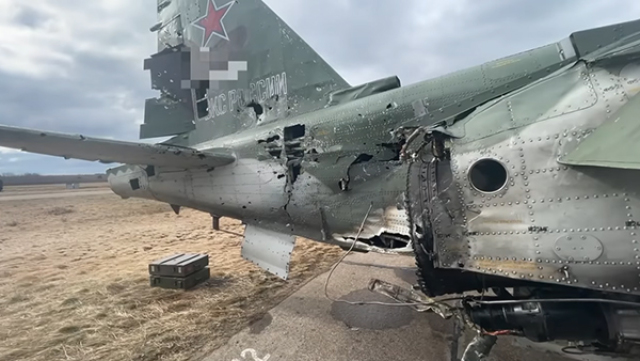Tens of thousands of portable anti-aircraft missile systems (MANPADS) were sent by the West to Ukrainian troops. It is assumed that these weapons should deprive the Russian military aviation of an advantage in the air. How do these systems work, what are the difficulties of using "Stingers" and how can Russian pilots counteract them?
For the first time, Soviet aviation encountered MANPADS during the war in Afghanistan. Ironically, the enemy turned out to be our Soviet Strela-2 complex, which received a baptism of fire during the Egyptian-Israeli "war of attrition". It was widely supplied to many states and it is not surprising that it also fell into the hands of the Mujahideen.
With the enemy MANPADS – portable anti-aircraft missile system FIM–92 Stinger (sting) - the USSR aviation collided there on September 25, 1986. The transfer of such weapons by the Americans to the Mujahideen was known. But the first use with the ambush of two of our helicopters when entering the Jalalabad airfield was nevertheless unexpected. That day we lost three pilots and two Mi-8MTs.
Now the United States is again supplying "Stingers" designed to fight Russian combat aircraft – this time to Ukraine. On March 7, the United States announced that, together with its NATO allies, they had sent 2,000 Stingers to Ukraine. And at the end of April, it was announced that the United States and its allies had sent 25,000 anti-aircraft missile systems to Kiev – first of all, it should be assumed, portable. Of course, we are not talking only about "Stingers", most likely, these are, to a large extent, again, "Arrows" and "Needles" of Soviet production.
However, these supplies are not so significant against the background of what Ukraine itself received during the division of the property of the Soviet Union – tens of thousands of Strela-2M and Igla-1 MANPADS. Since some of their elements were produced at the Arsenal plant in Kiev, she was able to organize the production of improved Strela-2MM complexes. It has established the production of all components up to rocket fuel.
To understand how dangerous such complexes are, first of all, let's consider what MANPADS are. This is a portable (jokingly they say – shoulder-mounted) anti-aircraft missile system that can be used by one shooter or operator. It is known that this is a short-range and high-altitude weapon. But few people imagine how small. Here is a table of the technical characteristics of four Western and two old Soviet complexes that can counteract the Russian aerospace Forces during a special military operation.
 |
| Characteristics of MANPADS. |
| Source: vz.ru |
The given parameters are more likely to confuse. For example, the two most popular ones are range and height. If MANPADS are specified in the TTX for Starstreak, respectively, 7 and 5 km, this does not mean that it will be able to reach the target at a distance of 7 km from the shooter and at an altitude of 5 km at the same time. 7 km is an inclined range. That is, the hypotenuse of a right triangle with a 5 km catheter . Thus, the distance from the arrow on the horizon in this case will be 4.9 km. The usual advertising technique of gunsmiths, when, for example, the maximum range and maximum combat load are indicated in one list of TTX, and these two parameters cannot be implemented simultaneously.
There are other subtleties – not every target can be hit at the maximum height, but only not maneuvering or slow-moving. In addition, each MANPADS is equipped with a battery and a cylinder with compressed or liquid gas combined with it. This element is another factor severely limiting the capabilities of the complex. To increase the sensitivity of the infrared sensor of the GOS, it has to be cooled down a lot. This is done with liquid argon – in "Stingers", compressed nitrogen – in "Arrows" and so on.
 |
| Characteristics of MANPADS. |
| Source: vz.ru |
But for the operation of both the starting mechanism and the onboard equipment, a power source is needed. There is no outlet in the field. No "energizer" can be inserted into a rocket at the factory so that it lies in a warehouse for ten years, and then its charge would be enough to operate the equipment. Therefore, the so–called ampoule battery is used - a chemical source of current for one-time use. It really generates a large current – that's just the duration of its operation is about 30-45 seconds. During this time, the shooter must find the target, capture it and launch.
However, a helicopter or an attack aircraft often appear unexpectedly and very close. The shooter must do all the operations to prepare the launch in just seconds. But the helicopter itself sometimes opens fire, at this time the aiming shooter with MANPADS is forced to stand in the open. If the arrow "seemed" – I heard the noise of an approaching helicopter, inserted a combined battery and cooling, activated... And the helicopter passed by and was not even visible because of the trees. The spent battery heats up so much (up to 400 degrees at the Stinger) that it can damage the trigger mechanism, and it needs to be urgently removed.
Ukraine was also promised French Mistral complexes. Its characteristics are somewhat better than the "Stinger", since it is a more modern development. A noticeable difference is only the use of different types of supports – tripods, or mounted on light vehicles, armored personnel carriers. The use of MANPADS "from the shoulder" is not provided.
Not quite traditional complexes have also appeared in Ukraine. First of all, it is the widely advertised British "Starstrik". The classic warhead for anti-aircraft guided missiles (SAM) are fragmentation. However, the British decided to be original: they used a warhead consisting of three submunitions – darts or spears.
This is a laser-guided complex. The operator searches for targets through an optical sight. Next, the laser illumination turns on, the target is captured for auto-tracking, but the operator must track the target through the sight so that it does not leave the laser scanning sector. The rocket starts and after acceleration to a speed of 3M, three darts are separated from it, which do not have their own engine, but are equipped with micro-steering wheels.
And that's where the miracles in the descriptions begin. The manufacturer's promotional materials say: after breeding, the spears are lined up in a triangular battle formation around the laser beam. In submunitions, in this case, it is necessary to have receivers and responders of laser radiation. Note that the rocket has a huge speed by the standards of such weapons – 1300 m / s. Under such conditions, it is almost impossible to provide a small near boundary of the affected area. In the TTX, it is declared 500 m, but technically it is unlikely.
Further. Guidance is carried out by the most primitive method, which provides the worst flight trajectory of the missiles with the greatest required overloads – there is nothing to be proud of. The stated incredibly high probability of hitting a target with a single missile – 0.96 – is most likely an inflated advertising figure.
In addition, Israel promised Ukraine a universal Spike NLOS – MR missile system. When describing it, I remember an old joke about a duck that can do a lot, namely run, jump, swim, dive, even fly, but does it all badly. The worst characteristics of all elements are a classic example of what is called the "price of versatility". This complex was developed as an anti-tank, but then the zealous owners decided to load it with air defense tasks. Why MANPADS tandem cumulative warhead? Extremely low speed of 180 m/s? Most likely, the real effectiveness of this complex in the fight against aerial targets can only be manifested when firing helicopters in hover mode.
How does Russian aviation, planes and helicopters, counteract all these types of weapons? Heat traps are immediately recalled (the correct name of the LTC, false thermal targets) – and yes, this is the first and mandatory method. However, it is far from the only one.
First of all, MANPADS make aviation "stratify". Part of it rises to heights inaccessible to MANPADS missiles. But this is acceptable for bombers, fighters, and then only in areas where there are no medium- and long-range air defense systems. Attack aircraft and helicopters, in any case, have to operate at extremely low altitudes. Airborne defense systems are being developed and are already being used for them.
It includes, for example, an optical-location station (OELS), or a special UV direction finder - it determines the moment and direction of the launch of MANPADS missiles. The optoelectronic suppression station can deflect anti-aircraft missiles using laser radiation or special (for example, electric) lamps. But the main method of countering MANPADS is special tactics of combat aviation. Without revealing all the details, we can mention some obvious techniques.
First, it is necessary to deprive the MANPADS shooters of time to prepare, capture the target and launch the missile. To do this, the pilots operate at extremely low altitudes, using the folds of the terrain. Demonstrative and distracting actions should be widely used. For example, in the case when the helicopter barely appeared, "teased", forced to activate the MANPADS – but did not enter the affected area. Reactivation of the complex will not be possible for some time, in addition, it will need a new battery.
Secondly, the crews must cover each other. The shooter of the MANPADS, which is being fired at, is unlikely to be able to effectively aim the missile at the target. Thirdly, aviation should use weapons with a launch range exceeding the range of MANPADS.
MANPADS are a real danger to aviation at low and extremely low altitudes. But the complex use of technical means and tactical techniques, plus the reliability of the equipment itself, can reduce losses. This is confirmed by military statistics – it says that seven anti-aircraft missiles are spent for one hit on the target. Despite the fact that a hit is not identical to a defeat – we have repeatedly seen that even damaged cars are brought by our pilots to the home airfield.
Igor Galaburda

